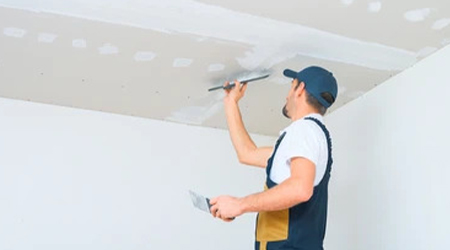
High ceilings can add a touch of grandeur and spaciousness to a room, but when it comes to taping and mudding, they pose unique challenges that require careful consideration and specialized techniques. In this guide, brought to you by Ontario Drywall and Taping, we’ll delve into the intricacies of overcoming challenges when taping and mudding high ceilings to ensure a flawless finish in your Ontario home.
Assessing the Scope of the Project: Before you begin, thoroughly evaluate the scope of your taping and mudding project for high ceilings. Take note of imperfections or damage, as addressing these issues upfront can save time and effort later in the process.
Choosing the Right Tools and Equipment: High ceilings require the right tools to ensure efficiency and safety. Invest in an extendable taping knife, a sturdy ladder, and a drywall lift for large sections. Quality tools can make a significant difference in the outcome of your project.
Proper Safety Measures: Safety should be a top priority when taping and mudding high ceilings. Ensure your ladder is stable and positioned on a level surface. Consider using safety harnesses and always have a spotter when working at elevated heights. Following safety guidelines reduces the risk of accidents during the project.
Working in Manageable Sections: Divide your high ceiling into manageable sections to make the project more approachable. Taping and mudding one section simultaneously allows for greater precision and control. It also minimizes the physical strain of reaching overhead for extended periods.
Thin and Consistent Layers of Joint Compound: Applying thin and consistent layers of joint compound is crucial for achieving a smooth finish on high ceilings. It ensures even coverage and helps prevent sagging and cracking over time. Take your time to feather the edges for a seamless transition.
Using the Right Type of Joint Tape: Choosing the appropriate joint tape for high ceilings is essential. Mesh tape is often preferred due to its flexibility and ability to adhere well to vertical surfaces. It provides added strength to joints and helps prevent cracking, especially in areas prone to movement.
Managing Drying Times: High ceilings may have different drying times than standard wall surfaces. Be patient and allow each layer of joint compound to fully dry before proceeding to the next application. Using fans and proper ventilation can expedite the drying process.
Sanding Techniques for Smooth Results: Sanding is critical in achieving a professional finish. Invest in a pole sander to reach high areas without constantly climbing up and down the ladder. Use fine-grit sandpaper for a smooth surface, ready for priming and painting.
Tackling the challenges of taping and mudding high ceilings requires a strategic approach and a suitable set of tools. With these expert tips from Ontario Drywall and Taping, you can confidently embark on your project, knowing that you know how to achieve a flawless finish that enhances the beauty of your elevated spaces in Ontario.





